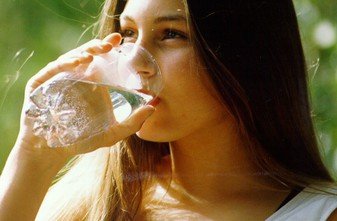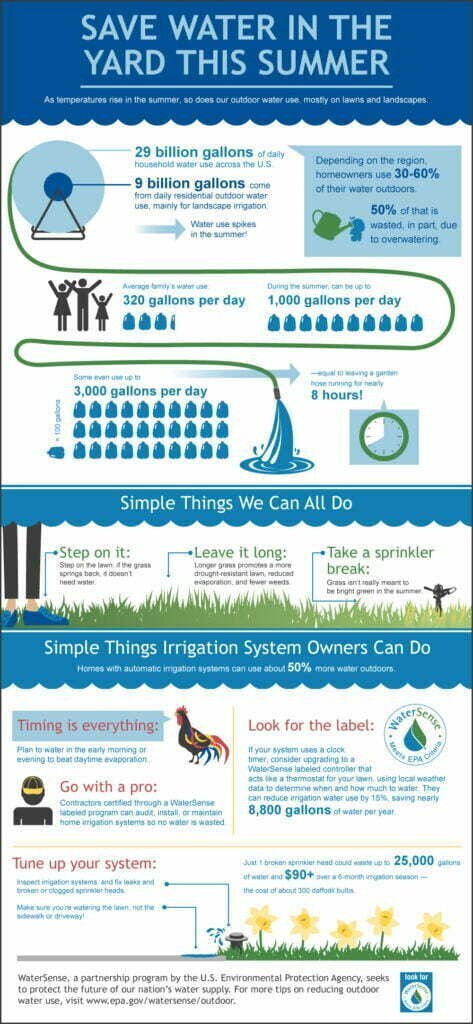Two billion people in the world lack access to clean water
Two billion people in the world lack access to drinking water and a reliable source of food. The world water shortage is a very real problem, and it’s only getting worse: by 2025, there will be another one billion mouths to feed in the world, and we will need one trillion cubic feet of water more than we use now just to grow the additional food we will need.

Americans use about 100 gallons of water per person per day: in Africa and most Third World countries, an entire family must get by on less than 3 gallons of water per day. And African and Indian women must each walk an average of four miles a day to carry 44 pounds of water every day. That’s enough man-hours (woman-hours?) to build 20 Empire State Buildings every day.

As the largest consumers of water in the world, can we Americans do anything to reduce our water footprint?
The answer is “Yes we can”.
If we make certain changes to our thinking – and then to our lifestyle – we can significantly reduce the amount of water we use – and waste – every day. We all have opportunities to make some serious changes in our homes, our yards, our diet, our consumption of manufactured goods: even reducing airline travel can save water.
Let’s take a look at how and where we can significantly reduce our water consumption by changing our behavior.
In the Home
We waste so much water in our homes that reducing our water consumption should be easy. Showering, bathing and using the toilet account for two-thirds of your home’s water consumption, so there’s lots of room for improvement.
- Use the new low-flow toilets which use 2 gallons per flush as opposed to the 5 gallons used by conventional toilets.
- Reduce your shower time by two minutes and save over 100 gallons per week.
- Use your dishwasher and don’t wash dishes by hand. A dishwasher uses about 5 gallons of water per load: washing the same number of dishes by hand can use over 20 gallons of water.
- Running a full bathtub of water uses about 75 gallons. Reduce your water consumption by taking short showers.
- Make your faucets “low-flow” by attaching an aerator to each faucet. Newer faucets will have an aerator already attached; you can add an aerator to most older faucet models. This will reduce the amount of water coming out of the faucet.
- Install energy-efficient appliances in your home. Dishwashers, washing machines, garbage disposal units and other products certified with the Energy Star label will help you to significantly reduce your residential water and power consumption.
- Use your water meter to check for hidden leaks. If your water meter runs overnight when you have no appliances running, you may have a leak somewhere on your property.
- Don’t let faucets leak: install new washers on all your faucets and always shut them tightly when you are done.
- Don’t keep the water running when shaving, brushing teeth and other bathroom activities.
- Use a bucket to collect excess water and use it to water your plants.
- Consider installing a “dual-plumbing” system which captures your “gray” water (water from bathtubs, sinks, and showers), filters and cleans it, stores it in underground tanks, and it can then be used to water plants and lawns. The system also collects and stores rain water for the same purpose. We did a blog post recently about a new home in northern California which was “dual-plumbed” from the get-go. Our master plumbers tell us that addressing the gray water issue is the most significant place where we can reduce our water footprint. Read more about recycling gray water here.
In The Yard
Your yard/garden, if it has a grass lawn, accounts for most of your water use. You can reduce water consumption in the following ways:
- Make a compost heap and put in all your kitchen waste rather than pushing it into the garbage disposal, which uses a lot of water.
- Sweep your yard rather than hosing it down. Then take the leaves and grass cuttings and put them in the compost heap.
- Don’t wash your car on your property: take your car/s to a car wash which recycles its water.
- Never water your flowers, plants or lawn during the day when it is hot: most of the water you use will evaporate and be wasted.
- Better yet, tear up your lawn and replace it with either bark, pebbles or sand. Your lawn uses most of the water in your household. Californians are now turning to non-lawn yards in the current drought, especially since Governor Brown mandated a 25% reduction in water use by every Californian beginning June 2015.
Changing Our Diet
Perhaps the biggest impact we can make on our consumption of water is to change our diet. Take a look at these foods and how much water is needed to produce them:
- Raising a cow for beef uses 2,400 gallons of water for each pound of beef produced. So you can save 600 gallons of water today by NOT eating that quarter-pound burger.
- Eat vegetables and fruit instead of meat – an apple uses only 18 gallons of water to grow, and an orange needs only 13 gallons.
- Reduce your wine and coffee consumption and you will start saving water right away. It takes 33 gallons of water to produce a single glass of wine, and 37 gallons to produce a single cup of coffee. Tea only needs 9 gallons of water to produce a single cup, so switch from coffee to tea and you are already reducing your water footprint.
- Eat salad instead of bread. It takes 200 gallons of water to produce a loaf of bread, and only 15 gallons to produce a lettuce.
- Other foods which require little water to produce are a Baked Potato (7 gallons), cereal (22 gallons) and eggs (36 gallons). Compare these to a pound of bacon, which requires 1,630 gallons of water to produce.
Reducing Our Energy Use
Producing energy uses a huge amount of water. We can significantly reduce our water consumption by reducing our consumption of energy.
Here are some facts about the energy we use and the water it takes to produce it:
- Using nuclear power consumes 250 gallons of water per household per day. Using solar energy uses only 25 gallons of water per household per day. Going solar immediately reduces your water footprint.
- Air travel uses more water than you can imagine. A flight from Los Angeles to Moscow uses about 10,000 gallons of water. So reduce your travelling and reduce your water consumption.
- It takes 13 gallons of water to produce a single gallon of gasoline. Reduce your driving, plan your errands and trips more efficiently, and you can reduce your water footprint.
- It takes 50 gallons of water to power one 100-watt light bulb for 10 hours. Turn off those lights when you don’t need them and you are immediately reducing your water consumption. Use energy-efficient light bulbs such as halogen incandescent bulbs, compact fluorescent lamps (CFLs), and light emitting diodes (LEDs). These bulbs use about 25%-80% less energy than traditional incandescent bulbs. So using them not only saves you money on your power bill, you also reduce your water footprint.
Consumption of Manufactured Goods
Producing manufactured goods uses a huge amount of water, and there may be room to reduce our consumption of manufactured goods to achieve a huge reduction in our water use. Take a look at these figures:
- It takes 100 gallons of water to grow a single pound of cotton fabric. And a pair of jeans uses 1,800 gallons of water in its production. The average American buys 35 lbs of new cotton material every year. So next time you want to buy another pair of jeans or one more t-shirt, think about whether you really need it. Buy recycled clothes and recycle them again when you’re done with them.
- The water used to make your laptop computer could wash 70 loads of laundry.
- Every pound of paper you recycle saves about 3.5 gallons of water. And buying recycled paper also saves water, since it takes 6 gallons of water to produce $1 worth of paper.
- It takes 40,000 gallons of water to manufacture an automobile. That includes the tires. You don’t need a new car every year – even if you can afford one.
Before we can change our lifestyle, we need to change our thinking. The water shortage is real, is going to get worse, and we CAN do something about reducing our consumption of water.
The average American uses 100 gallons of water per day. Nowhere in the world do people use so much water: the average African or Indian family has to get by on less than 4 gallons per day.
So don’t expect people in the third world to cut their water consumption. Americans are the only people in the world who can reduce their water consumption.
If we change our thinking and then our behavior, especially in our energy consumption and in our diets, we can start to significantly reduce the amount of water we consume. It’s up to us – each one of us can make a difference.




